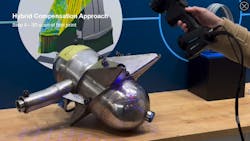Integrating Industrial CT and Connected Platforms to Streamline Machine Design and Manufacturing
What You’ll Learn
- The role of industrial CT scanning in providing detailed surface and internal material data for design validation and quality control
- How digital twins and simulation models incorporate real-world inspection data to improve part performance predictions.
- The importance of connected digital platforms for enabling collaboration across design, manufacturing and inspection teams
- Current challenges and standardization efforts supporting adoption of advanced metrology and manufacturing integration technologies.
Industrial computed tomography (CT) scanning has gained importance across multiple engineering sectors, including mechanical design, aerospace, defense and medical devices. Machine design engineers are using advanced technologies for product development from concept to production. A recent deep-dive conversation with experts from Hexagon Manufacturing Intelligence at the company’s Hexagon LIVE event this past May in Las Vegas shed some light on how industrial CT scanning and connected manufacturing platforms are reshaping engineering workflows.
Initially developed for medical applications, CT now delivers both surface geometry and internal material information, supporting engineering activities from quality control to design optimization. “If a company is not doing industrial CT scans, they risk falling behind,” said Roger Wende, senior business development manager. Wende and Mathieu Perennou, global strategy and business development director, Additive Manufacturing Solutions, sat down with Machine Design to talk about the non-destructive testing side of Hexagon’s business.
READ MORE: How Hexagon Nexus Is Navigating the Shift to Industry 5.0
A key advantage of industrial CT is its ability to close the loop between physical parts and digital models. As Wende explained, “You can scan the part and then send it back to the finite element analysis team to take a look at how it actually performed on a real part vs. a design part,” he said.
Unlike traditional inspection methods, industrial CT delivers both surface and internal material information, enabling comprehensive analysis during all engineering phases, from design verification to production floor quality control. This closed-loop workflow feeds real-world scanned data back into simulation models. This feedback helps engineers refine designs early, preventing costly downstream issues. For example, Wende offered an example that a detailed CT scan of an injection-molded plastic connector revealed fiber orientation problems, which was causing frequent fractures. These insights would have been impossible to capture without such non-destructive testing, he said.
Design for Manufacturing and More
Engineering experts emphasize the importance of design alignment with manufacturing. realities, particularly in additive manufacturing (AM). While AM offers design freedom, not all geometries are feasible to print or finish. Wende explained that Hexagon’s Nexus platform facilitates collaboration across design, manufacturing and inspection teams, providing a digital thread tha
READ MORE: Q&A: Advancing Metrology with Handheld 3D Scanners
He said that Nexus acts much like a multifunctional collaboration hub, combining real time data sharing akin to Microsoft Teams, CRM functionalities reminiscent of Salesforce, and presentation capabilities similar to PowerPoint. This integration streamlined processes those companies toward connected manufacturing ecosystems, Perrenou added.
Digital Twins and Simulation Integration
During our conversation, Wende also touched on the evolution of digital twins—virtual replicas of physical products used in design, validation and prediction by integrating CT scan data capturing manufacturing induced defects and porosities into finite element analysis (FEA) and fatigue simulations, engineers can gain a more accurate representation of part performance and longevity.
Correlating virtual fatigue test results with physical testing enables fine-tuning of software models, reducing the need for extensive physical prototypes and costly certification testing, he said. One aerospace case study involved redesigning lightweight brackets by integrating scanned arrived geometric and defect data into structural mechanical simulations, precisely predicting failure points confirmed by actual crack testing.
Standards and Interoperability, Harnessing AI and Deep Learning
Despite these advanced capabilities, Wende acknowledges continuing challenges and standardizing industrial CT as a metrology tool and integrating smart technologies into complex mechanical systems. Collaborative efforts among academia, automotive, aerospace and medical manufacturing partners are necessary to develop and refine ASTM, AWS and European VDE standards, Perennou noted. These frameworks improve measurement confidence and enable interoperability for faster adoption and innovation within design and manufacturing silos.
READ MORE: Hexagon Expands Software Capabilities with Acquisition of 3D Systems’ Geomagic Suite
We couldn’t exit our discussion without bringing up the topic of artificial intelligence (AI). Wende said that AI is a game changer, especially in automating CT data segmentation and defect detection. Deep learning models segment scans with dramatically reduced processing times from hours to seconds while improving accuracy by identifying defects beyond traditional grayscale analysis, Perennou explained, adding that early applications in battery analysis have paved the way for broader use in casting and additive manufacturing inspections.
Bridging analog and digital eras while witnessing exponential technology advances have unique challenges and opportunities, Wende said, adding that the future promises more efficient, transparent and innovative machine design processes.
About the Author
Sharon Spielman
Technical Editor, Machine Design
As Machine Design’s technical editor, Sharon Spielman produces content for the brand’s focus audience—design and multidisciplinary engineers. Her beat includes 3D printing/CAD; mechanical and motion systems, with an emphasis on pneumatics and linear motion; automation; robotics; and CNC machining.
Spielman has more than three decades of experience as a writer and editor for a range of B2B brands, including those that cover machine design; electrical design and manufacturing; interconnection technology; food and beverage manufacturing; process heating and cooling; finishing; and package converting.
Email: [email protected]
LinkedIn: @sharonspielman
Facebook: Machine Design
YouTube: @MachineDesign-EBM



